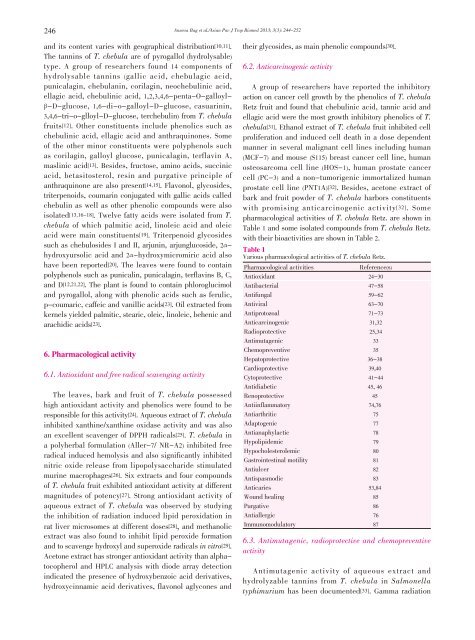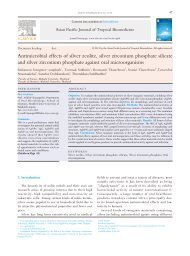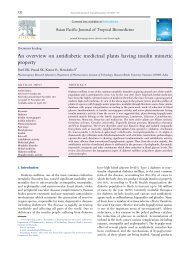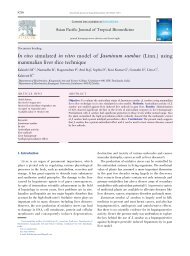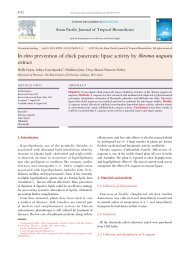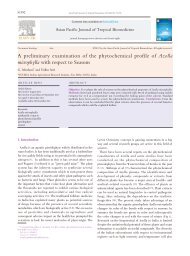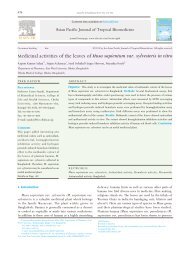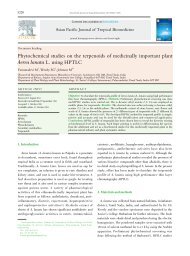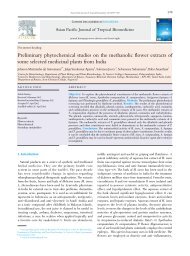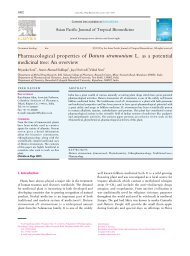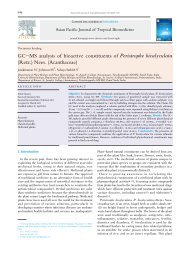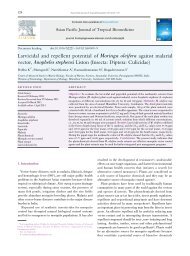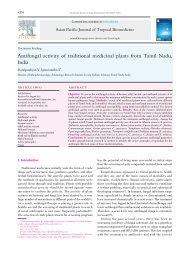Therapeutic potential of Terminalia chebula Retz ... - Apjtb.com
Therapeutic potential of Terminalia chebula Retz ... - Apjtb.com
Therapeutic potential of Terminalia chebula Retz ... - Apjtb.com
Create successful ePaper yourself
Turn your PDF publications into a flip-book with our unique Google optimized e-Paper software.
246<br />
and its content varies with geographical distribution[10,11].<br />
The tannins <strong>of</strong> T. <strong>chebula</strong> are <strong>of</strong> pyrogallol (hydrolysable)<br />
type. A group <strong>of</strong> researchers found 14 <strong>com</strong>ponents <strong>of</strong><br />
hydrolysable tannins (gallic acid, <strong>chebula</strong>gic acid,<br />
punicalagin, <strong>chebula</strong>nin, corilagin, neochebulinic acid,<br />
ellagic acid, chebulinic acid, 1,2,3,4,6-penta-O-galloylβ-D-glucose,<br />
1,6-di-o-galloyl-D-glucose, casuarinin,<br />
3,4,6-tri-o-glloyl-D-glucose, terchebulin) from T. <strong>chebula</strong><br />
fruits[12]. Other constituents include phenolics such as<br />
chebulinic acid, ellagic acid and anthraquinones. Some<br />
<strong>of</strong> the other minor constituents were polyphenols such<br />
as corilagin, galloyl glucose, punicalagin, terflavin A,<br />
maslinic acid[13]. Besides, fructose, amino acids, succinic<br />
acid, betasitosterol, resin and purgative principle <strong>of</strong><br />
anthraquinone are also present[14,15]. Flavonol, glycosides,<br />
triterpenoids, coumarin conjugated with gallic acids called<br />
chebulin as well as other phenolic <strong>com</strong>pounds were also<br />
isolated[13,16-18]. Twelve fatty acids were isolated from T.<br />
<strong>chebula</strong> <strong>of</strong> which palmitic acid, linoleic acid and oleic<br />
acid were main constituents[19]. Triterpenoid glycosides<br />
such as chebulosides I and II, arjunin, arjunglucoside, 2αhydroxyursolic<br />
acid and 2α-hydroxymicromiric acid also<br />
have been reported[20]. The leaves were found to contain<br />
polyphenols such as punicalin, punicalagin, terflavins B, C,<br />
and D[12,21,22]. The plant is found to contain phloroglucimol<br />
and pyrogallol, along with phenolic acids such as ferulic,<br />
p-coumaric, caffeic and vanillic acids[23]. Oil extracted from<br />
kernels yielded palmitic, stearic, oleic, linoleic, behenic and<br />
arachidic acids[23].<br />
6. Pharmacological activity<br />
6.1. Antioxidant and free radical scavenging activity<br />
The leaves, bark and fruit <strong>of</strong> T. <strong>chebula</strong> possessed<br />
high antioxidant activity and phenolics were found to be<br />
responsible for this activity[24]. Aqueous extract <strong>of</strong> T. <strong>chebula</strong><br />
inhibited xanthine/xanthine oxidase activity and was also<br />
an excellent scavenger <strong>of</strong> DPPH radicals[25]. T. <strong>chebula</strong> in<br />
a polyherbal formulation (Aller-7/ NR-A2) inhibited free<br />
radical induced hemolysis and also significantly inhibited<br />
nitric oxide release from lipopolysaccharide stimulated<br />
murine macrophages[26]. Six extracts and four <strong>com</strong>pounds<br />
<strong>of</strong> T. <strong>chebula</strong> fruit exhibited antioxidant activity at different<br />
magnitudes <strong>of</strong> potency[27]. Strong antioxidant activity <strong>of</strong><br />
aqueous extract <strong>of</strong> T. <strong>chebula</strong> was observed by studying<br />
the inhibition <strong>of</strong> radiation induced lipid peroxidation in<br />
rat liver microsomes at different doses[28], and methanolic<br />
extract was also found to inhibit lipid peroxide formation<br />
and to scavenge hydroxyl and superoxide radicals in vitro[29].<br />
Acetone extract has stronger antioxidant activity than alphatocopherol<br />
and HPLC analysis with diode array detection<br />
indicated the presence <strong>of</strong> hydroxybenzoic acid derivatives,<br />
hydroxycinnamic acid derivatives, flavonol aglycones and<br />
Anwesa Bag et al./Asian Pac J Trop Biomed 2013; 3(3): 244-252<br />
their glycosides, as main phenolic <strong>com</strong>pounds[30].<br />
6.2. Anticarcinogenic activity<br />
A group <strong>of</strong> researchers have reported the inhibitory<br />
action on cancer cell growth by the phenolics <strong>of</strong> T. <strong>chebula</strong><br />
<strong>Retz</strong> fruit and found that chebulinic acid, tannic acid and<br />
ellagic acid were the most growth inhibitory phenolics <strong>of</strong> T.<br />
<strong>chebula</strong>[31]. Ethanol extract <strong>of</strong> T. <strong>chebula</strong> fruit inhibited cell<br />
proliferation and induced cell death in a dose dependent<br />
manner in several malignant cell lines including human<br />
(MCF-7) and mouse (S115) breast cancer cell line, human<br />
osteosar<strong>com</strong>a cell line (HOS-1), human prostate cancer<br />
cell (PC-3) and a non-tumorigenic immortalized human<br />
prostate cell line (PNT1A)[32]. Besides, acetone extract <strong>of</strong><br />
bark and fruit powder <strong>of</strong> T. <strong>chebula</strong> harbors constituents<br />
with promising anticarcinogenic activity[32]. Some<br />
pharmacological activities <strong>of</strong> T. <strong>chebula</strong> <strong>Retz</strong>. are shown in<br />
Table 1 and some isolated <strong>com</strong>pounds from T. <strong>chebula</strong> <strong>Retz</strong>.<br />
with their bioactivities are shown in Table 2.<br />
Table 1<br />
Various pharmacological activities <strong>of</strong> T. <strong>chebula</strong> <strong>Retz</strong>.<br />
Pharmacological activities Reference(s)<br />
Antioxidant 24-30<br />
Antibacterial 47-58<br />
Antifungal 59-62<br />
Antiviral 63-70<br />
Antiprotozoal 71-73<br />
Anticarcinogenic 31,32<br />
Radioprotective 25,34<br />
Antimutagenic 33<br />
Chemopreventive 35<br />
Hepatoprotective 36-38<br />
Cardioprotective 39,40<br />
Cytoprotective 41-44<br />
Antidiabetic 45, 46<br />
Renoprotective 45<br />
Antiinflammatory 74,76<br />
Antiarthritic 75<br />
Adaptogenic 77<br />
Antianaphylactic 78<br />
Hypolipidemic 79<br />
Hypocholesterolemic 80<br />
Gastrointestinal motility 81<br />
Antiulcer 82<br />
Antispasmodic 83<br />
Anticaries 53,84<br />
Wound healing 85<br />
Purgative 86<br />
Antiallergic 76<br />
Immunomodulatory 87<br />
6.3. Antimutagenic, radioprotective and chemopreventive<br />
activity<br />
Antimutagenic activity <strong>of</strong> aqueous extract and<br />
hydrolyzable tannins from T. <strong>chebula</strong> in Salmonella<br />
typhimurium has been documented[33]. Gamma radiation


